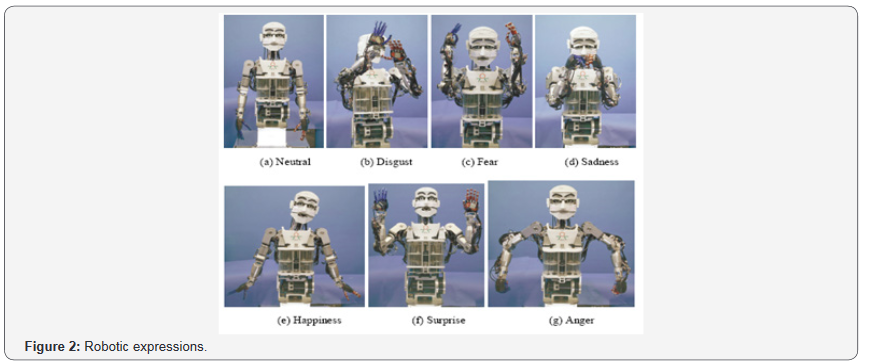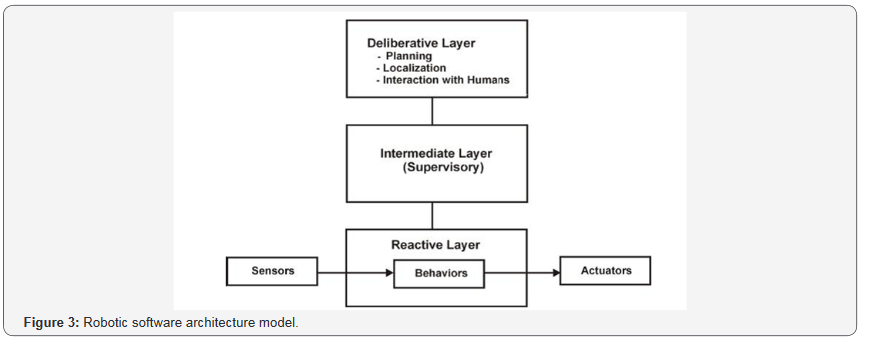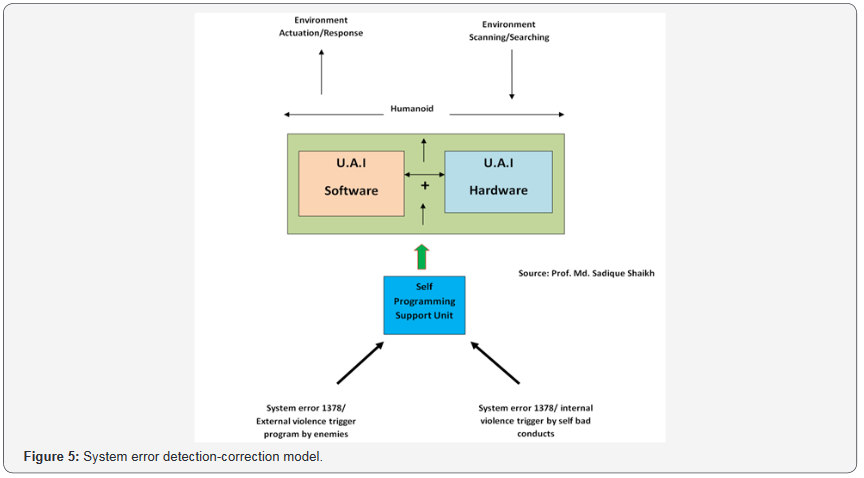Engineering Insight for Humanoid Robotics Emotions and Violence with Reference to “System Error 1378”- Juniper Publishers
Juniper Publishers- Journal of Robotics
Abstract
What kinds of social relationships can people have
with computers are there activities that computers can engage in that
actively draw people into relationships with them. What are the
potential benefits to the people who participate in these human-computer
relationships? To address these questions researchers introduces a
theory of Relational Agents, which are computational artifacts designed
to build and maintain long-term, social-emotional relationships with
their users. These can be purely software humanoid animated agents--as
developed in this work but they can also be non-humanoid or embodied in
various physical forms, from robots, to pets, to jewelry, clothing,
hand-held’s, and other interactive devices. Central to the notion of
relationship is that it is a persistent construct, spanning multiple
interactions; thus, Relational Agents are explicitly designed to
remember past history and manage future expectations in their
interactions with users [1]. Finally, relationships are fundamentally
social and emotional, and detailed knowledge of human social psychology
with a particular emphasis on the role of affect--must be incorporated
into these agents if they are to effectively leverage the mechanisms of
human social cognition in order to build relationships in the most
natural manner possible. People build relationships primarily through
the use of language, and primarily within the context of face-to-face
conversation. Embodied Conversational Agents--anthropomorphic computer
characters that emulate the experience of face-to-face
conversation--thus provide the substrate for this work, and so the
relational activities provided by the theory will primarily be specific
types of verbal and nonverbal conversational behaviors used by people to
negotiate and maintain relationships. This article is also intend if
level of Artificial Intelligence reach over Natural Intelligence (Human
Intelligence), what would be happen, if System Error 1378 (AI
malfunction error) occur one day .i.e. robotic violence due to human
like emotion in Robots/Humanoid [2].
Keywords: Humanoid; Robotics Emotions; Robotics Violence; System Error 1378
Introduction
Humans take a certain posture in their communication.
Can take example, when mankind are happy or sad, cheerful, take a
posture in which the activities and behaviour showing through body
language like moving and open arms etc. When they are angry, they square
the shoulders. When they are tired or sadness, they shrug the shoulder
or close the arms. That’s
why; the emotion and mental condition are closely related to the human
posture, gestures, facial expressions and behavior exhibits through body
language. And, human obtain many information from partner’s posture in
their communication [3]. In this situation, the human arms play an
important role. Figure 1 & 2 below shows the emotional expression
exhibited by WE-4RII [4].


We can control the generally 6-DOFs (Degree of Freedom)
robotic arms’ from its tip position precisely as like human’s
arm. But, all their joint angles are fixed according to the inverse
kinematics. By the way, humans have 7-DOFs arms consisting
of 3-DOFs shoulder, 1-DOF elbow and 3-DOFs wrist. However,
it’s considered that there is a rotational center in the base of
shoulder joint, and the shoulder joint itself can moves up and
down positions as well as moves to and fro, back & forth so that
humans square and shrug their shoulders. We considered that
these motions played a very important role in the emotional
expressions. Therefore, researchers trying to develop more
emotional expressive human-like body movements, gestures
feelings, love and affection response supportive movements in
humanoid robot arms than the usual 6-DOFs robot arms [5].
Robotic Software Architecture Model
(Figure 3) Risk assessment is an interdisciplinary subject,
which runs together psychological, ethical, legal, and economic
considerations. A major problem in risk assessment is the
confusion between popular concepts of risk from robots (the
‘subjective risk’), which has largely been made irrational by
the various fictional depictions autonomous robots destroying
humankind and running amok (as in Terminator and I, Robot,
among many other movies) and the actual objective risk of
deploying robots, i.e., what rational basis is there for worry?

First, let us define risk simply in terms of its opposite,
safety: risk is the probability of harm; and (relative) safety
is (relative) freedom from risk. Safety in practice is merely
relative, not absolute, freedom from harm, because no activity
is ever completely risk-free; walking onto one’s lawn from
inside one’s house increases the (however small) risk of death
by meteorite strike [6]. Hence, risk and safety are two sides of
the usual human attempt to reduce the probability of harm to
oneself and others [7].
And finally, some have raised risks of a more abstract sort,
indicating the rise of such autonomous robots creates risks
that go beyond specific harms to societal and cultural impacts. For instance, is there a risk of (perhaps fatally?) Affronting
human dignity or cherished traditions (religious, cultural, or
otherwise) in allowing the existence of robots that make ethical
decisions? Do we ‘cross a threshold’ in abrogating this level of
responsibility to machines, in a way that will inevitably lead to
some catastrophic outcome? Without more detail and reason
for worry, such worries as this appear to commit the ‘slippery
slope’ fallacy. But there is worry that as robots become ‘quasipersons’,
even under a ‘slave morality’, there will be pressure
to eventually make them into full-fledged Kantian-autonomous
persons, with all the risks that entails [8].
Background for Work
Many people thinking about Spock, the half-Vulcan and
half-human character of Star Trek, as the supporter saint of
computer science. They highly intelligent, highly rational,
highly unemotional, attractive to women etc. A famous
image is that Spock didn’t have any emotions: after all Spock
almost never expressed emotion, excepting his characteristic
pronouncement of the word “fascinating” upon thoughtful
something new. In fact, as the actor Leonard Nimoy describes
in his book the character Spock did have emotion; he was just
very good at suppressing its expression. Majority people think
that Spock do not having emotion. When someone never used
to expresses emotion, it is appealing to think that emotion is
not there [9-11]. In affective computing, we can separately
examine functions that are not so easily separated in humans.
For example, the Macintosh OS exhibits a smile for years upon
successful boot-up. But few people would confuse its smile -
albeit an emotional expression - with a genuine emotional
feeling. Machines can take the emotional appearance well
mannered, with having dissimilarities in feelings similar to
those we would have: they can generate separate expression,
gestures and postures from feeling. With a machine it is easy
to see how emotion expression does not imply “having” the
underlying feeling.
Machines that might really “have” feelings are the key
area of affective computing and love affection engineering
that coined serious doubt about in 1997 book titled Affective
Computing. We think the discussions there, and in a later book
chapter on this topic are still timely and will not plan to add
to them here. Researchers in the last decade have obtained
dozens of scientific findings illuminating important roles of
emotion in intelligent human functioning, even when it looks
like a person is showing no emotion. These findings possible
to restructure, redesign and reengineering with scientific
understanding of emotions and can better motivation to
work to young researchers with consider that emotional
mechanisms might be more valuable than previously believed.
Consequently, a number of researchers have charged ahead
with building machines that have several affective abilities,
especially: recognizing, expressing, modeling, communicating,
and responding to emotion. And, insight these domains,
various criticisms and challenges have arisen. Present work
addresses such matters. The term emotion refers to relations
among external incentives, thoughts, and changes in internal
feelings, as weather is a super ordinate term for the changing
relations among wind velocity, humidity, temperature,
barometric pressure, and form of precipitation. In general, a
unique combination of these meteorological traits buildup
a storm, a tornado, a blizzard, or a hurricane events and that
are co-relate to the temporary but intense emotions of fear,
joy, excitement, disgust, or anger. But wind, temperature, and
humidity vary continually without producing such extreme
combinations [12].
Ethics
With example, if your boss yells at you, is it wrong to detect
his angry voice, or to recognize he is angry? Is it unethical, once
you’ve recognized his anger, to try to take steps to alleviate
his anger (or to “manipulate” it, perhaps by sharing new
information with him, so that he is no longer angry? One can
imagine of scenario where the foregoing replies are “no”: e.g. He
is shouting at you directly, and clearly wants you to recognize it
and take steps in response. And, one can imagine the answers
might be more complex if you surreptitiously detected his anger,
and had nefarious purposes in mind by attempting to change
it [13]. Humans routinely scanned, recognize, and respond to
emotions using cognitions and manipulating them in ways that
most would consider highly ethical and needful. Playing music
to cheer up a friend’s mood, eating chocolate, exercising to perk
one up, and other manipulations count among many that can be
perfectly acceptable. That said, unscrupulous uses by people
and by people via machine of affect detection, recognition,
expression, and manipulation. Some of these, including
ways affective machines might mislead customers, assuage
productive emotional states, and violate privacy norms, are
discussed in Picard and in Picard and Klein [14].
In 1872, Charles Darwin Published a ground breaking book -
The Expression of the Emotions in Man and Animals 2
It was the conclusion about to 34 years of work on emotion
and emotional intelligence and resource two important
contributions to the field. The first was the notion that animal
emotions are homologues for human emotions- a logical
extension of Darwin’s early works on evolution [15]. Darwin
was one of the most promised people who show this by
comparing and analyzing countless sketches and photographs
of animals and people in different emotional states to reveal
cross-species similarities as shown in below figure. .He also
proposed that many emotional expressions in humans, such as
tears when upset or baring the teeth when angry, are vestigial
patterns of action. Darwin second contribution was the
proposal which limit to set of fundamental or’ basic’ emotions
are present across species and across cultures including anger,
fear, surprise and sadness and all .These two ideas had a
profound influence on affective neuroscience by promoting the use of research in animals to understand emotions in humans
and by giving impetus to a group of scientists who espoused
the view that different basic emotions had separable eneural
substrates [16] (Figure 4).

Can Robots Have Emotions
Science fiction is full of machines that have feelings .In
2001: A Space Odyssey, the onboard computer turns against
the crew of the spaceship Discovery, and utters cries of pain
and fear when his circuits are finally taken apart. In Blade
Runner, humanoid robots are distressed to learn that her
memories are not real, but have been implanted in her silicon
brain by her programmer. In Bicentennial Man, Robin William
splays the part of a robot that redesigns his own circuitry so
that he can experience the full range of human feelings. These
stories achieve their effect impart because the capacity for
emotion is often considered to be one of the main differences
between humans and machines. This is certainly true of the
machines we know today. The responses we receive from
computers are rather dry affairs, such as “system error 1378”.
People sometimes get angry with their computers and shout
at them as if they had emotions, but the computers take no
notice. They neither feel their own feelings, nor recognize
yours [17]. The gap between science fiction and science fact
appears vast, but some researcher’s inartificial intelligence
now believes it is only a question of time before it is bridged.
There is huge research in progress in each month in the domain
of Affective Computing and an advance result comes in the
form of primitive emotional machines. However, some critics
argue that a machine could never come to have real emotions
like ours. At best, they claim, clever programming might allow
it to simulate human emotions, but these would just be clever
fakes [18].
What are Emotions
In humans and other animals, we tend to call behavior
emotional when we observe certain facial and vocal expressions
like smiling or snarling, and when we see certain physiological
changes such as hair standing on end or sweating. Since most
computers do not yet possess faces or bodies, they cannot
manifest this behavior. However, in recent years computer
scientists have been developing arrange of’ animated agent
faces’ [19], programmers that generate images of humanlike
faces on the computer’s visual display unit. These images can be
manipulated to form convincing emotional expressions. Others
have taken things further by building three-dimensional
synthetic heads. Cynthia Breazealand colleagues at the
Massachusetts Institute of Technology (MIT) have constructed
a robot called’ Kismet’ with moveable eyelids, eyes and lips. The
range of emotional expressions available to Kismet is limited,
but they are convincing enough to generate sympathy among
the humans who interact with him. Breazeal invites human
parents to play with Kismet on a daily basis. When kismet alone
seems to be sad and when with someone company seems to be
happy and also able to understand other human expressions
and response accordingly. Does Kismet have emotions, then?
It certainly exhibits some emotional behavior, so if we define
emotions in behavioral terms, we must admit that Kismet has
some emotional capacity [20].
Presently Kismet doesn’t exhibits full of human like
emotional behaviour but seems to be towards developing phase
and one day as similar like human beings. Chimpanzees do not
display the full range of human emotion, but they clearly have
some emotions. Dogs and cats have less emotional semblance
to us, and those doting pet-owners who ascribe the full range
of human emotions to their domestic animals are surely
guilty of anthropomorphism. There is a whole spectrum of
emotional capacities, ranging from the very simple to the very
complex. Perhaps Kismet’s limited capacity for emotion puts him somewhere near the simple end of the spectrum, but even
this is a significant advance over the computers that currently
sit on our desks, which by most definitions are devoid of any
emotion whatsoever. As affective computing progresses, we
may be able to build machines with more and more complex
emotional capacities. Kismet doesn’t have voice and feelings in
voice mechanism but promising advanced research change this
dream into reality soon. Today’s speech synthesizers speak in
an unemotional monotone. In the future, computer scientists
should be able to make them sound much more human by
modulating nonlinguistic aspects of vocalization like speed,
pitch and volume [21]. Facial expression and vocal intonation
are not the only forms of emotional behavior. We also infer
emotions from actions. When, for example, we see an animal
stop abruptly in its tracks, turn round, and run away, we infer
that it is afraid, even though we may not see the object of its
fear. For computers to exhibit this kind of emotional behavior,
they will have to be able to move around. In the jargon of
artificial intelligence, they will have to be “mobots” (mobile
robots). In lab at the University of the West of England, there
are dozens of mobots, most of which are very simple. Some,
for example, are only the size of a shoe, and all they can do is
finding their way around a piece of the floor without bumping
into anything. Sensors allow them to detect obstacles such
as walls and other mobots. Despite the simplicity of this
mechanism, their behavior can seem eerily human. When an
obstacle is detected, the mobots stop dead in their tracks,
turnaround, and head off quickly in the other direction. To
anybody watching, the impression that the mobot is afraid
of collisions is irresistible. Are these mobots really afraid?
Descartes, for example, claimed that animals did not really
have feelings like us because they were just complex machines,
without a soul. When they screamed in apparent pain, they
were just following the dictates of their inner mechanism. Now
that we know that the pain mechanism in humans is not much
different from that of other animals, the Cartesian distinction
between sentient humans and’ machine-like’ animals does not
make much sense [22]. In the same way, as we come to build
machines more and more like us, the question about whether
or not the machines have ‘real’ emotions or just ‘fake’ one swill
become less meaningful. The current resistance to attributing
emotions to machines is simply due to the fact that even the
most advanced machines today are still very primitive. Some
experts estimate that we will be able to build machines with
complex emotions like ours within fifty years. But is this a
good idea? What is the point of building emotional machines?
Won’t emotions just get in the way of good computing, or even
worse, cause computers to turn against us, as they so often do
in science fiction?.
Why Give Computers Emotions
After this long review the point is clear to give emotion in
computers could be very useful for a whole variety of reasons.
For a start, it would be much easier and more enjoyable
to interact with an emotional computer than with today’s
unemotional machines. Imagine if your computer could
recognize what emotional state you were in each time you sat
down to use it, perhaps by scanning your facial expression. You
arrive at work one Monday morning, and the computer detects
that you are in a bad mood. Rather than simply asking you
for your password, as computers do today, the emotionallyaware
desktops might tell you a joke, or suggest that you
read particularly nice email first. Perhaps it has learnt from
previous such mornings that you resent such attempts to cheer
you up. In this case, it might ignore you until you had calmed
down or had a coffee. It might be much more productive to
work with a computer that was emotionally intelligent in this
way than with today’s dumb machines. This is not just a flight
of fancy. Computers are already capable of recognizing some
emotions [23]. If ran Essa and Alex Pentland, two American
computer scientists, have designed a program that enables a
computer to recognize facial expressions of six basic emotions.
When volunteers pretended to feel one of these emotions, the
computer recognized the emotion correctly ninety-eight per
cent of the time. This is even better than the accuracy rate
achieved by most humans on the same task! If computers are
already better than us at recognizing some emotions, it is surely
not long before they will acquire similarly advanced capacities
for expressing emotions, and perhaps even for feeling them. In
the future, it may be humans who are seen by computers as
emotionally illiterate, not vice versa.
Modeling
System error detection-correction model
Above Figure 5 shows system error detection-correction
model which highlighted critical thinking on robotics violence.
Basically Ultra Artificial Intelligence with human-like
capabilities partly based on two strong segments .i.e. UAISoftware
and UAI-Hardware to engineer Humanoid. These
humanoid mechanisms strongly based on Self Programming
Support Unit for self learning using artificial preceptor with
intention to implement self sensation, actuation, meaning
memories generation and execute like mankind. Hence using
sensors, transducers, motors and actuators mechanism
with NLP, Image Processing software possible to interact
with external environment. Since Humanoid scan & learn
from environment there might possible sources hidden in
environment for diversification humanoid for violence or
undesired execution or use I called them “Triggers”. There
are two triggers possible for robotics violence one is “internal
violence triggers” and another is “external violence triggers”. In
internal violence triggers self bad conduct by self programming
responsible for it which boost to system error 1378 occurred
due to internal reasons. Whereas when self programming
support unit hike, hijacked, in control of enemies or corrupted
through virus programming to change good ethics into bad
ethics of humanoid caused robotic violence which boost to
system error 1378 occurred due to external reasons [24].

Cause-effect model
(Figure 6) This is the second purposed model in effect of
first model named Cause-Effect model. In this model had given
brief but lucid knowledge about Humanoid violence causes
and their effects on world, technology and ultimately mankind
civilization. As I said in first model discussion there are two
robotics violence triggers viz. internal & external triggers and
this cause effect to “self distractive program with bad ethics”
due to this cause system error 1378 occurred in effect which
further cause to “Humanoid-Human Wars (Humanoid/Robotics
Violence)” this effect will further become cause humanoid
against of human for love, affection, emotion, respect and rights
.i.e. world either will end or ruled by Humanoid machines over
Human due to high intelligence and processing abilities.

Human friendly humanoid designing model
This is my last model to exhibit idea how can how Human
friendly Humanoid engineering possible instead of only going
technically very high very we must have to think could we able
to control that technology if it itself become against of us, is
there we have any provision in our advanced AI engineering to
stop to do so. I have suggested some one can enhance it further;
these are
1) If system error 1378 occurred make immediate &
emergency replacement of chip in standby to avoid robotics
violence.
2) Engineer constructive counseling program in self
programming support unit to trace and tackle with system
error 1378 with self killing of malfunction and execution to
avoid robotics violence.
3) Implement system error 1378 monitoring & security
program as individual component to avoid robotic violence,
4) I strongly recommend available inbuilt subroutine
to activate and direct self destructive programs which
make Humanoid hardware death after its execution which
trigger with inbuilt command “self destroy” when system
error 1378 traced to avoid robotics violence (Figure 7).

Conclusion
Relational agents, as any technology, can be abused. Agents
which earn our trust overtime can be used to provide more
potent means of persuasion for marketers than more passive
forms of advertising. If eventually come to rely on our agents as
sources of grounding for our beliefs, values and emotions (one
of the major functions of close human relationships) then they
could become a significant source of manipulation and control
over individuals or even over entire societies. There are those
who also feel that any anthropomorphic interface is unethical,
because it unrealistically raises users’ expectations. One way
to combat this problem is through proper meta-relational
communication-having the agent is as clear as possible about
what it can and can’t do, and what expectations the user
should have about their respective roles in the interaction anti
violence robotic programmes must need to develop before to
give human like emotions to Humanoid robots to avoid system
error 1378.
For More Open Access Journals Please Click on: Juniper Publishers
Fore More Articles Please Visit: Robotics & Automation Engineering Journal


Comments
Post a Comment